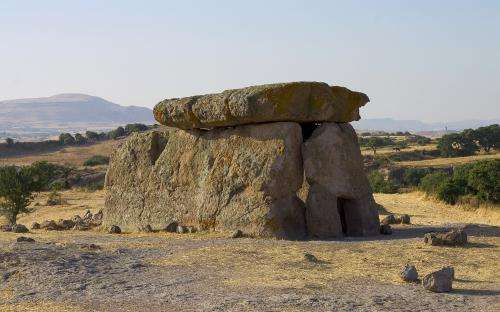Common genetic ancestors lived during roughly same time period

Mitochondrial Eve and Y-chromosomal Adam—two individuals who passed down a portion of their genomes to the vast expanse of humanity—are known as our most recent common ancestors, or MRCAs. But many aspects of their existence, including when they lived, are shrouded in mystery.
Now, a study led by the Stanford University School of Medicine indicates the two roughly overlapped during evolutionary time: from between 120,000 to 156,000 years ago for the man, and between 99,000 and 148,000 years ago for the woman.
"Previous research has indicated that the male MRCA lived much more recently than the female MRCA," said Carlos Bustamante, PhD, a professor of genetics at Stanford. "But now our research shows that there's no discrepancy." Previous estimates for the male MRCA ranged from between 50,000 to 115,000 years ago.
Bustamante is senior author of the new study, which will be published Aug. 2 in Science. Graduate student David Poznik is the lead author.
Despite the Adam and Eve monikers, which evoke a single couple whose children peopled the world, it is extremely unlikely that the male and female MRCAs were exact contemporaries. And they weren't the only man and woman alive at the time, or the only people to have present-day descendants. These two individuals simply had the good fortune of successfully passing on specific portions of their DNA, called the Y chromosome and the mitochondrial genome, through the millennia to most of us, while the corresponding sequences of others have largely died out due to natural selection or a random process called genetic drift.
The DNA sequences traced by the researchers were chosen because of the unique way they are inherited: the Y chromosome is passed only from father to son, and the mitochondrial genome is passed from a mother to her children. Each can serve as a useful tool for determining ancestral relationships because they don't undergo the shuffling and swapping of genetic material that occurs routinely in most human chromosomes.
The researchers made their discovery by comparing Y-chromosome sequences among 69 men from nine globally distinct regions, including some that have only recently been available for study. Regions represented included Namibia, the Democratic Republic of Congo, Gabon, Algeria, Pakistan, Cambodia, Siberia and Mexico.
New, high-throughput sequencing technologies allowed the researchers to identify about 11,000 differences among the sequences. These variants enabled them to establish phylogenetic relationships and timelines among the sequences with unprecedented accuracy.
"Essentially, we've constructed a family tree for the Y chromosome," said Poznik. "Prior to high-throughput sequencing, the tree was based on just a few hundred variants. Although these variants had revealed the main topology, we couldn't say much about the length of any branch—the number of variants shared by all of its descendants. We now have a more complete structure, including meaningful branch lengths, which are proxies for the periods of time between specific branching events."
Bustamante and Poznik obtained highly accurate sequencing results over a length of about 10 megabases of Y chromosome DNA (or 10 million nucleotides) for each of the 69 individuals. They then estimated the yearly mutation rate on the Y chromosome by calibrating it with a known event: the human settlement of the Americas that occurred about 15,000 years ago. Mutations shared by all Native Americans today must have existed prior to the peopling of the continents, whereas many of those that vary among indigenous American populations arose during the past 15,000 years. They repeated their analysis with the individuals' mitochondrial DNA to generate the two estimates of MRCA timing, showing for the first time that they overlap.
But the Y chromosome tree they constructed did more than just identify a time period for the MRCA. It also clarified some previously unknown relationships that occurred among populations as humans expanded out of Africa into Eurasia. "We can now date certain events very precisely," said Bustamante. "We found a single variant that shows how three ancient lineages came together about 48,000 years ago, plus or minus only a couple of hundred years. The accuracy is exquisite." The tree also exemplifies the extraordinary depth of genetic diversity present among modern Africans.
It's difficult to say what the apparent overlap between the male and female MRCA sequences may represent, if anything. The vagaries of inheritance are easy to see even within individual human families, and the timing could simply be a fluke. But it's also possible that it represents a time when only a few sequences were passed on and many died out due to an external event that's not yet been identified. "For the most part, it's a random process," said Poznik. "Some lineages die out, some are successful. But it's also possible that there may be elements of human demographic history that predispose these lineages to coalesce at certain times."
More information: "Sequencing Y Chromosomes Resolves Discrepancy in Time to Common Ancestor of Males versus Females," by G.D. Poznik et al. Science, 2013.
Journal information: Science
Provided by Stanford University Medical Center



















